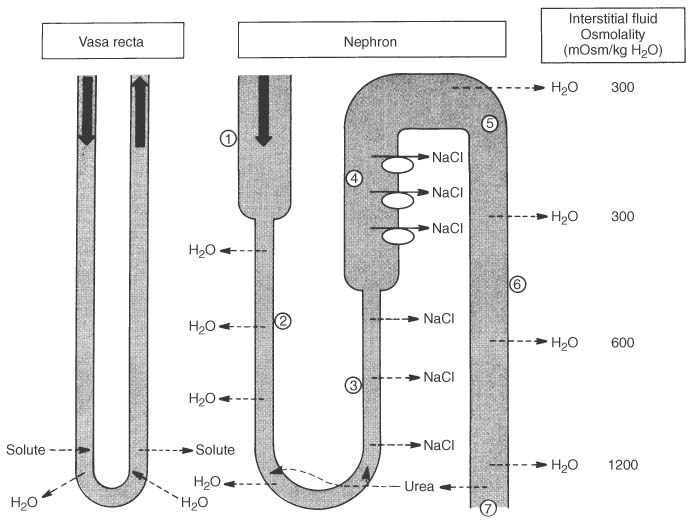 |
 |
Figure 20-8
Tubular concentration of urine. The juxtamedullary nephrons
have long loops of Henle associated with the vasa recta. Dashed
arrows represent passive movement of fluid or solutes along concentration
or osmolar gradients; solid arrows represent active
transport. Tubular fluid enters the distal proximal tubule iso-osmotic with plasma
(300 mOsm/kg) (1). In the descending limb of Henle (2), water rapidly diffuses out
into the increasingly hypertonic medulla and is removed by the vasa recta, and as
a consequence, the tubular fluid becomes hypertonic, largely because of concentration
of sodium chloride (NaCl). Urea diffuses in from the hypertonic interstitium, further
increasing tubular fluid osmolality (1200 mOsm/kg). In the thin ascending loop of
Henle (3), NaCl passively diffuses into the interstitium along its concentration
gradient, but water is trapped in the water-impermeable tubule, which progressively
decreases tubular fluid osmolality. Urea passively diffuses into the tubular fluid
(urea recycling). Tubular dilution is accelerated by active reabsorption of NaCl
in the thick ascending loop (the diluting segment) and proximal distal tubule (4).
The fluid entering the distal tubule is quite hypo-osmotic (100 mOsm/kg). In the
collecting segment (5), the osmolality of the tubular fluid returns to that of plasma
(300 mOsm/kg), but unlike the contents of the proximal tubule, the solute component
consists largely of urea, creatinine, and other excreted compounds. Increased plasma
antidiuretic hormone (ADH) renders the cortical and medullary collecting ducts (6)
permeable to water, which passively diffuses into the hypertonic medullary interstitium.
Even though some urea diffuses out into the medulla, the maximal osmolality of concentrated
urine (7) approaches that of the hypertonic medullary interstitium, about 1200 mOsm/kg.
In the absence of ADH, the collecting ducts remain impermeable to water, and the
urine is diluted. (From Stanton BA, Koeppen BM: Control of body fluid osmolality
and volume. In Berne RM, Levy MN [eds]: Physiology,
4th ed. St Louis, CV Mosby, 1998, pp 715–743.)

 |
